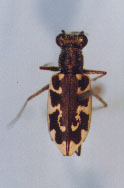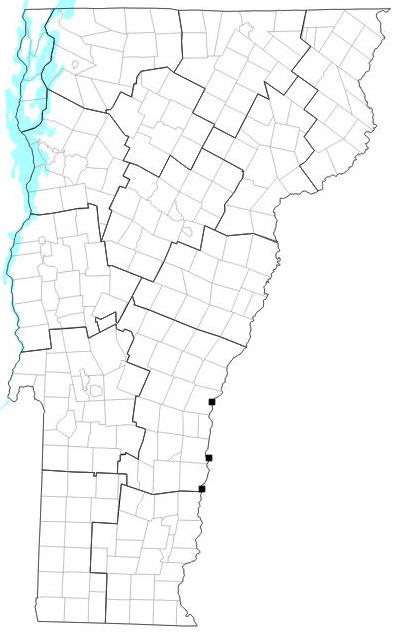Identification
The Puritan tiger beetle is a medium-sized terrestrial beetle. It has long legs and dark bronze-brown to green wing covers with cream-colored markings on the upper surface. This beetle often occurs with the more common Bronzed Tiger Beetle (Cicindela repanda), which is stouter, has white markings on the wing covers that do not connect along the edges, and is metallic blue-green under the body. In contrast, the Puritan tiger beetle appears longer and thinner, has whitish markings that connect along the outer margins of the wing covers, and has white hairs on the underbody. The Puritan tiger beetle appears whitish and shining in bright sunlight, while Bronzed Tiger Beetle is more of a chocolate brown and shows a blue flash from underneath when it flies.
General Range
Shores of the Connecticut River, formerly from Hartland, VT to Cromwell, CT and (disjunct) from the shores of Chesapeake Bay, MD. Old museum specimens labelled “N.Y.” and “N.J.” may indicate a wider range in the 19th century. In New England only a few small populations, comprising a single metapopulation (a group of spatially separated subpopulations of the same species which interact at some level) remain in New England; one along the Connecticut River, near Hadley, Massachusetts and the others near Cromwell, Connecticut. Because of dam-building and modifications of the Connecticut River, only a remnant of the once extensive Puritan tiger beetle populations remains there. In New England, Puritan tiger beetle distribution follows the sand and clay deposits formed by glacial lakes during the last ice age.
Local Range
Vermont, according to K.W. Cooper there was one old, undated specimen formerly in the Dartmouth College collection labeled “Hartland, Vt.” This is the only record for the Vermont side of the river. There were two localities along the Connecticut River in New Hampshire – Claremont and Charlestown. The species has not been seen in NH since 1939 and is probably extinct in both states.
Habitat
Adults were found on or just below riverside bluffs of sand or alternating sand and clay layers. In the Chesapeake Bay localities, the adults forage on the narrow sand beach below the bluff except at high tide, when they move up onto the cliff face. In New England, presumably, the adults would have moved onto the cliff face in times of high water. Larvae have been found in burrows on the sand beach in New England and in the cliff face on the Chesapeake. In CT surviving populations are on sand banks not associated with tall bluffs. The species there shares the sand banks with C. repanda (Omland, pers. comm.). Dam building and flood control have had a disastrous effect on the Connecticut River populations by greatly decreasing the erosion by the river. The sand banks are no longer eaten back at their bases making the cliffs more stable and resulting in vegetation invading the cliffs. This is likely the primary cause of the disappearance of the species from our states.
Life Cycle
This species usually has a two-year life cycle, with both winters spent as larvae. Some individuals may develop in only one year. Adults emerge in early June. Peak numbers and most matings occur in July and the adults disappear in August. Most adult activity is confined to July when adults of C. repanda are absent, thus reducing competition between the two.
Behavior
Although primarily diurnal, this species is also active at night (Knisley and Schultz 1997). According to Wickham (1899), the adult can recognized by its posture (head held high, caudal end low).
Conservation Status
The total population in New England is less than 1,000; more than 99 percent of the remaining New England population is found only in Connecticut. Puritan Tiger Beetle populations are limited by the availability of sandy beach habitat along rivers, which tends to occur below large river bends. Some historical sites where beetles occurred have been lost to bank stabilization around cities and by habitat loss due to flooding behind dams. The operation of flood control and hydroelectric dams has changed the way rivers flow and flood, possibly affecting the forces which create and maintain river beaches. At least one site, in Massachusetts, appears to be threatened by heavy recreational use. This species is listed as Threatened both federally and by Vermont.
Flight Period
June – August
More Information








